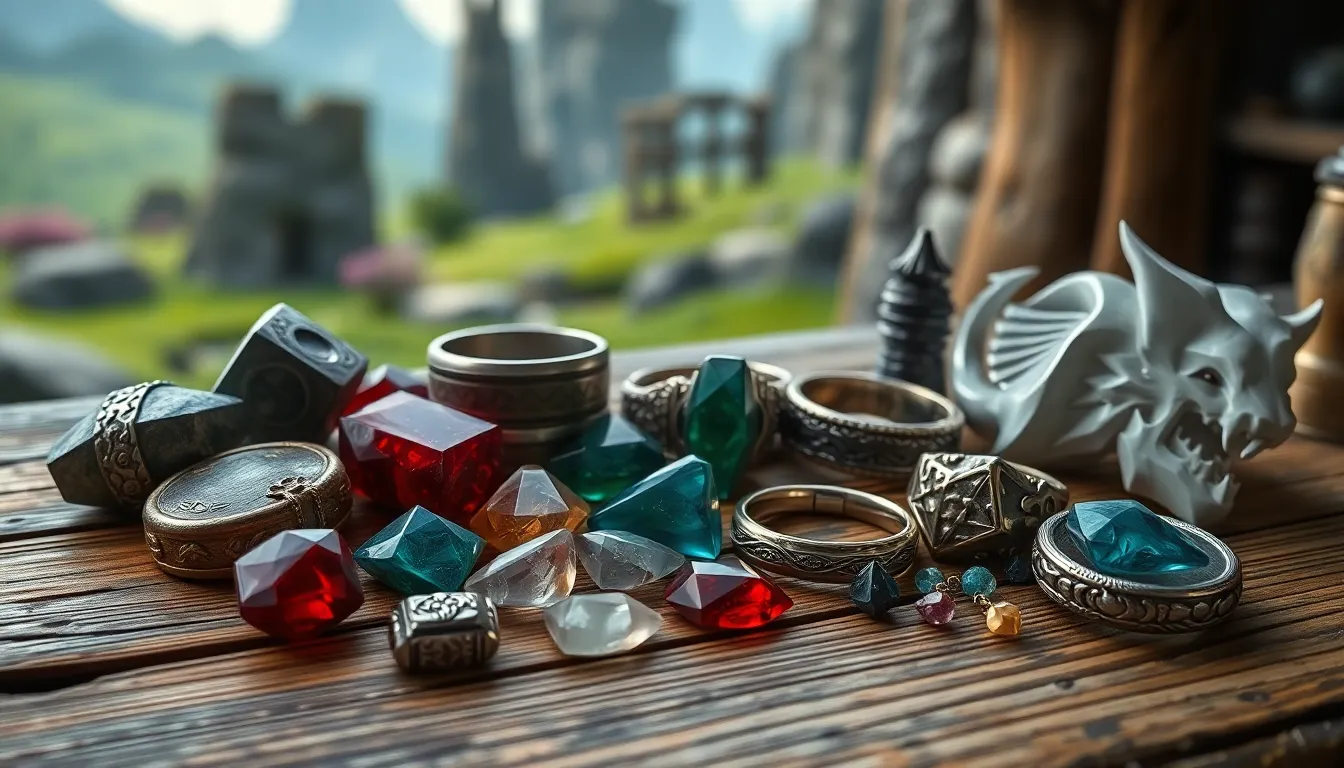In the vast and treacherous world of Elden Ring, players face daunting challenges that test their skills and strategies. To survive and thrive, understanding upgrades is crucial. These enhancements not only improve weapons and armor but also elevate gameplay, allowing players to tackle more formidable foes and explore deeper realms.
Upgrades in Elden Ring offer a pathway to personalization, enabling players to tailor their characters to fit unique playstyles. Whether it’s boosting attack power or enhancing defense, the right upgrades can make all the difference in a game filled with peril. As players journey through this captivating landscape, mastering the upgrade system becomes essential for conquering the game’s many trials.
Table of Contents
ToggleOverview of Elden Ring Upgrades
Upgrades play a pivotal role in Elden Ring, directly impacting gameplay quality. Players enhance weapon and armor performance through upgrades, significantly increasing damage output and defense. Upgrades not only serve to combat formidable foes but also allow for personalization of character builds.
Types of Upgrades
- Weapon Upgrades: These increase attack power, scaling with chosen attributes. Available through blacksmiths, weapons can be infused or upgraded for unique effects.
- Armor Upgrades: These enhance defense statistics against various damage types. Armor sets can also improve players’ resistances to environmental effects.
- Talismans: These provide passive bonuses that alter gameplay dynamics. Talismans can significantly shift strategies during encounters.
Upgrade Materials
Upgrading requires specific materials, such as:
| Material Type | Usage | Locations |
|---|---|---|
| Smithing Stones | Weapon upgrades | Found in caves and ruins |
| Bloodstones | Armor upgrades | Dropped by elite enemies |
| Golden Seeds | Flask upgrades | Found near sacred sites |
Upgrade Benefits
Upgrades yield various benefits, including:
- Enhanced Survival: Upgraded gear improves player survivability against higher enemy levels.
- Custom Playstyles: Tailored upgrades support different combat strategies, aligning with individual play preferences.
- Progressive Difficulty Handling: Upgrades enable players to tackle increasingly challenging enemies and bosses.
Understanding and mastering the upgrade system is crucial for success in Elden Ring. Effective use of upgrades translates to better performance and a more enjoyable gaming experience.
Types of Upgrades

Elden Ring features several types of upgrades crucial for enhancing gameplay. Each upgrade type plays a significant role in improving a player’s effectiveness in combat and survival.
Weapons Upgrades
Weapons upgrades focus on boosting attack power and overall weapon effectiveness. Players can enhance their weapons through the following methods:
- Smithing Stones: Used to upgrade standard weapons at various crafting locations. Different stone types correspond to specific upgrade levels.
- Special Infusions: Alter a weapon’s attributes, adding elemental damage or scaling with specific stats.
- Ashes of War: Equip unique skills to weapons, providing additional abilities in combat.
Upgrading weapons ensures players can face stronger foes more efficiently.
Armor Upgrades
Armor upgrades enhance defense and resistance against different damage types. Key components include:
- Bloodstones: Used to upgrade armor sets, providing increased protection against physical and elemental attacks.
- Weight Considerations: Players must balance armor weight to maintain agility while maximizing defense.
- Resistances: Upgrades may improve resistances to status ailments, crucial for surviving enemy attacks.
Effective armor upgrades can significantly improve a player’s survivability.
Talismans Upgrades
Talismans upgrades provide passive boosts that enhance gameplay. They include:
- Upgrade Materials: Seek specific items to strengthen talismans, increasing their effects.
- Effect Variety: Talismans can improve health, boost magic damage, or enhance defensive capabilities.
- Strategic Use: Combining talismans with other upgrades allows for tailored gameplay styles, adapting to various challenges.
Investing in talismans upgrades can create significant advantages in combat situations.
Upgrade Systems Explained
Elden Ring’s upgrade systems are crucial for enhancing gameplay. Players can boost their equipment using various crafting materials, allowing for improved performance in battle.
Crafting Materials
Crafting materials are essential for upgrades. Players utilize specific items to enhance weapons, armor, and flasks:
- Smithing Stones: Required for weapon upgrades, found in mines and caves.
- Bloodstones: Necessary for armor enhancements, collected from defeated enemies and explored treasure chests.
- Golden Seeds: Used to upgrade flasks, often located near shrines or within certain enemy camps.
- Ashes of War: Infusions that provide unique skills to weapons, obtainable from specific locations or bosses.
Understanding where to find these materials streamlines the upgrading process, making progression smoother.
Upgrade Levels
Upgrade levels determine the strength of equipment. Each weapon and armor piece can undergo multiple upgrade tiers:
- Tier 1: Basic upgrades provide a minor increase in attack or defense values.
- Tier 2: Improves performance significantly, allowing players to face stronger adversaries.
- Tier 3: Offers major enhancements, unlocking additional abilities or resistances.
- Tier 4: Represents the peak potential for upgrades, maximizing equipment effectiveness.
Mastering upgrade levels enhances survivability, ensuring players can adapt to the game’s escalating challenges.
Strategies for Maximizing Upgrades
Maximizing upgrades in Elden Ring involves strategic resource management and precise timing. Players can optimize their experience by understanding when and how to use upgrade materials effectively.
Resource Management
Effective resource management is crucial for upgrades. Players benefit from prioritizing significant resources like Smithing Stones, Bloodstones, and Golden Seeds. Gathering materials consistently ensures readiness for weapon and armor enhancements.
- Collect regularly: Smithing Stones often appear in mines or caves, while Bloodstones drop from defeated enemies or can be found in treasure chests. Gathering these materials in abundance prevents delays in upgrading.
- Store wisely: Players should store excess materials for future upgrades. Avoid unnecessary usage, especially for higher-tier resources, until they reach critical upgrades.
- Plan upgrades: Assess which weapons and armor benefit most from immediate upgrades. Focus on primary equipment to maximize combat efficiency before branching out to secondary items.
Timing of Upgrades
Timing significantly impacts the effectiveness of upgrades. Knowing when to upgrade equipment can enhance gameplay experience.
- Prioritize major thresholds: Players should aim for upgrades before entering tougher zones. This preparation allows characters to withstand increased enemy difficulty.
- Upgrade after major bosses: Players often acquire significant resources after defeating bosses. Immediately utilizing these can provide a substantial advantage in upcoming battles.
- Balance upgrades: Avoid upgrading all items at once; instead, space out upgrades across different equipment. This strategy keeps the player versatile and adaptable to various combat situations, ensuring that they are prepared for any encounter.
Mastering the upgrade system in Elden Ring is essential for any player aiming to conquer its formidable challenges. By enhancing weapons and armor players not only boost their combat effectiveness but also tailor their gameplay to fit their unique styles. Gathering the necessary materials and understanding the upgrade levels can significantly impact performance in tougher encounters.
Strategic resource management and timely upgrades ensure that players remain prepared for the ever-increasing difficulty. Embracing the intricacies of upgrades allows for a richer and more rewarding gaming experience, ultimately leading to greater success in the vast world of Elden Ring.





